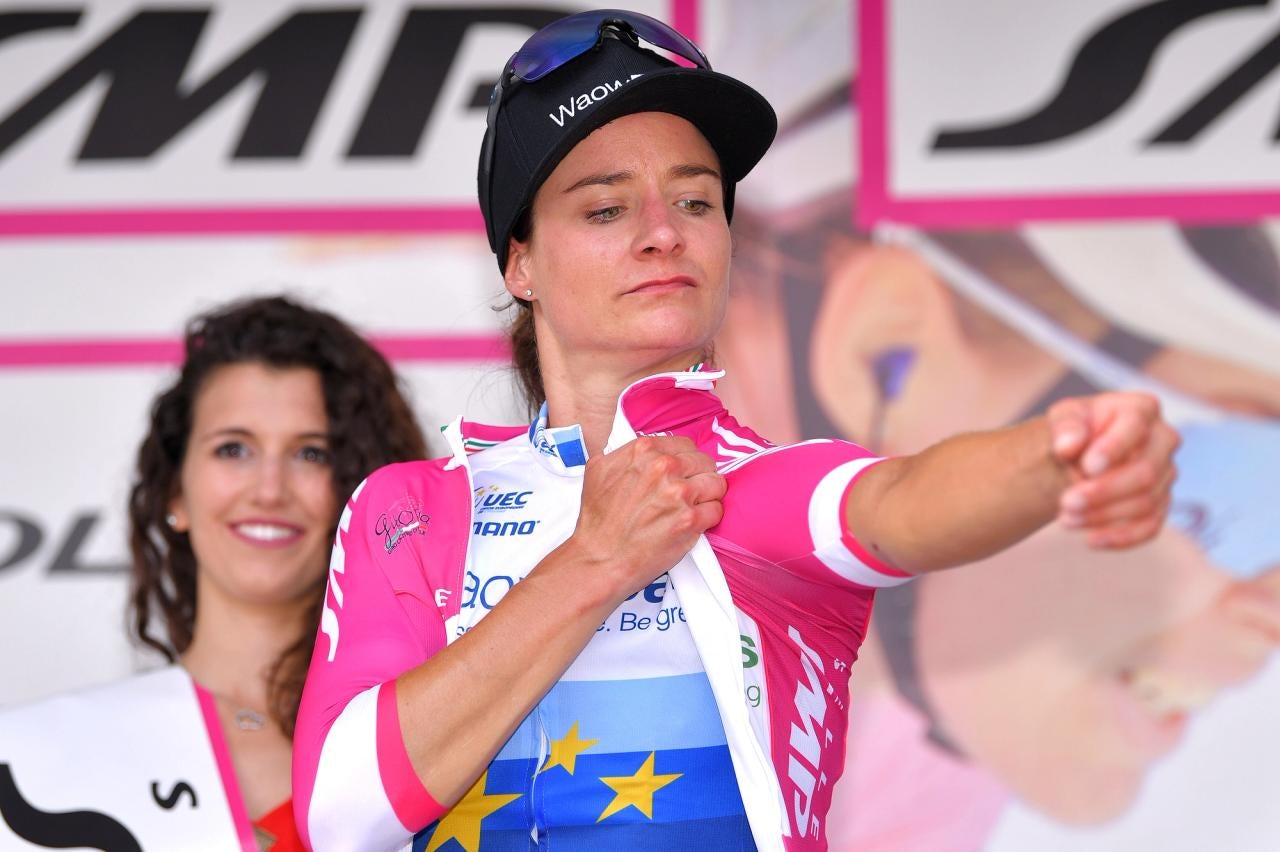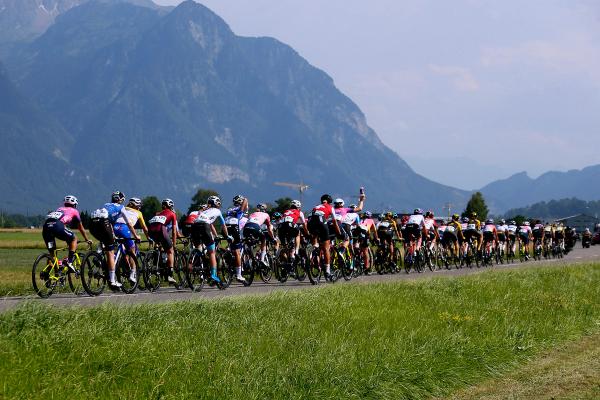A brief history of the Giro d’Italia Donne
Looking back at women’s cycling’s original ‘Grand Tour’
Matilda Price
Racing News Editor
Velo Collection (Luc Claessen) / Getty Images
Marianne Vos holds the record for most stage wins at the Giro d’Italia Donne, with 32. the Giro Donne, with the baby pink on the right.
In 2023, the Giro d’Italia Donne is coming to the end of one era, and preparing to enter a new one. After years of bouncing around various owners and organisers, the race is due to be taken over by RCS Sport in 2024, the organisers of the men’s Giro d’Italia. This will mark a new age for the race, bringing it in line with races like the Tour de France Femmes and the Vuelta a España in being linked to their men’s equivalents and under the same brand. But it’s important to remember that this is a race that already boasts a rich - if underappreciated - history.
The first incarnation of the race took place back in 1988, long before many of the races we know now were born, and it’s the longest-running stage race on the calendar. Its roll of honour includes almost all of the biggest names in the sport, and has always been held as one of the most important races to win. From Fabiana Luperini’s dominance in the nineties, to the ascendency of Marianne Vos and the era of Anna van der Breggen versus Annemiek van Vleuten, so much women’s cycling history has played out at this race. 2023 may be about looking towards the new future of the race, but before that, let’s take a proper look at its past.
1988-1990: the beginnings
The first women’s Giro, then called the Giro d’Italia Femminile, took place in 1988 and was eight stages long. Starting in Milan, the race route traversed northern Italy and south towards its finish in Rome. In many ways, the race looked similar to how it does now, a mix of road stages and a time trial making up the week of racing, and it was the second-biggest race in Italy after the long-running Trofeo Alfredo Binda. That first edition was won by Maria Canins, the best Italian rider of her generation who had won the Tour de France Féminin in 1985 and 1986. She came close to doing the Giro and Tour double that year - nearly 30 years before Annemiek van Vleuten did the same in 2022 - but fell just short, finishing second to Jeannie Longo a few weeks later in France.
Perhaps surprisingly, Canins did not win the Giro again. It was another Italian, Roberta Bonanomi, who won in 1989 - a much less well known name than Canins, but nevertheless one of the best stage racers of the eighties and nineties. The first non-Italian winner was France’s Catherine Marsal in 1990, the Giro win the jewel in the crown of one of the best seasons a rider has ever had: she won the Tour de l’Aude, the Postgiro Féminin, the Giro, the French national championships, the World championships and the Tour de France Féminin, all in a few short months. It was clear from the start that the Giro was one of the big races that female riders wanted to win.
One thing we can’t ignore when looking at the history of women’s racing is how little we actually know about it. Whilst you can go back and find the tiniest detail about stages of the men’s Tour de France gone by, it’s difficult to even trace stage results for the early editions of the Giro. Women’s cycling was happening, riders and teams were putting everything into racing, but the position of the sport was still such that sometimes, no one even remembered to write down what had happened.
.jpg?w=1348&auto=format)
Bettiniphoto
The early years of the Giro, with the baby pink jersey on the right.
1993-2000: Luperini dominance
After not being held in 1991 and 1992, the Giro returned in 1993, and the Giri of the nineties can only be defined by one thing: Fabiana Luperini. The likes of Luzia Zberg, Imelda Chiappa and Linda Jackson tried to challenge the imperious Italian, and they came close, but the Giro was hers and hers only from 1995 to 1998, winning four editions on the bounce. Lenka Ilavská and Michela Fanini took the titles in 1993 and 1994, but in 1995 a 21-year-old Luperini lined up for her first Giro, and the rest was history.
In the nineties, Luperini won 13 stages of the Giro, a completely dominant force in her home race. Such repeated success was somewhat rare in that era of women’s cycling, where riders found it difficult to sustain a high level career for so many years, but Luperini began to change that, and the Giro was fertile ground. Despite her relative weakness in the time trials, that never hindered Luperini, who was able to take enough time in the climbing to secure the pink jersey year on year.
It wasn’t until 1999, the first time Luperini missed the Giro, that another rider won: the Spaniard Joane Somarriba. Luperini returned to the race in 2000, but a buoyed Somarriba was on even better form than the previous summer, winning the Giro again before also winning the Grande Boucle Féminine, relegating Luperini to outside the podium spots. The other thing that changed in the nineties was the Giro’s length: it grew from eight stages to 12 and 13 stages in the latter half of the decade.
2001-2013: the precarious growth of women’s cycling
At the turn of the millennium, women’s cycling was beginning to change, but the change was precarious. Since its introduction to the Olympics in 1984, the sport was beginning to be taken more seriously with races like La Flèche Wallonne and the Primavera Rosa - a women’s version of Milan-San Remo - starting to draw lines between the men’s and women’s pelotons. As the 2000s would show, though, that change was delicately balanced, and sometimes things went backwards before they went forwards.
After looking like it was on a growth trajectory in terms of size, the Giro shrunk back down to nine stages in 2002, as longer stage races struggled on the calendar. Races like the Grande Boucle Féminine and the Tour de l’Aude were the biggest races for a peloton that was at a higher level year on year, but they struggled in the face of poor sponsorship and coverage. Many of these races didn’t survive to the end of the 2000s, and the Giro is one of the few races that is a constant between the nineties and today.
![Riders like Emma Johansson, Emma Pooley and Nicole Cooke [R-L] were frequent competitors at the Giro during the 2000s and 2010s.](https://cdn.sanity.io/images/hk2y3slq/production/29bbea381d3c433c204f7dfc4f45736056ec2561-4256x2832.jpg/GettyImages-533196026.jpg?w=1348&auto=format)
Velo Collection (Tim de Waele) / Getty Images
Riders like Emma Johansson, Emma Pooley and Nicole Cooke [R-L] were frequent competitors at the Giro during the 2000s and 2010s.
In those years, the Giro roll of honour is punctuated by some of the biggest names in what was a golden era of stage racing: Nicole Brändli, Nicole Cooke, Fabiana Luperini one final time, Mara Abbott as the American contingent burst onto the climbing and time trialing scene, and Marianne Vos’s back-to-back overall wins in 2011 and 2012. Perhaps the only name missing from that era is Emma Pooley: the decorated Brit never quite managed to take home the pink jersey, twice finishing in the runner up spot.
2014-present: the Giro as we know it
Having survived the tumultuous time at the end of the 2000s that saw many big races fall by the wayside, the Giro from 2014 onwards starts to look like the race we know now. It returned to ten stages in 2014, and the list of competitors starts to look much more familiar: Marianne Vos continued winning, perhaps revealing how much of an all-rounder’s rather than climber’s race the Giro was for several years, Rabobank and Boels-Dolmans started to dominant, Anna van der Breggen took her first overall title.
The race has gone through some big changes in the last ten years, being passed around organisers, changing its name from the Giro Rosa to the Giro Donne, and briefly losing WorldTour status after continued shortcomings in TV coverage, but it’s also carved out a strong identity in the calendar. The Giro remains the longest race for the women’s peloton, and it has undoubtedly benefited from the growing professionalisation and recognition of women’s cycling, helped by the introduction of the Women’s WorldTour in 2016. It’s also upped its difficulty level, featuring big climbs and summit finishes to really become comparable to a Grand Tour for women.

Velo Collection (Dario Belingheri) / Getty Images
Anna van der Breggen won the Giro d’Italia Donne in 2015, 2017, 2020 and 2021.
In recent years, the Giro has become the Annemiek van Vleuten and Anna van der Breggen show, with the pair winning seven of the last eight editions between them. This year, Van Vleuten will hope to match Van der Breggen’s four wins before she joins her compatriot in retirement. In the absence of any other major stage races, before the launch of the Tour de France Femmes in 2022, the Giro has long been the pinnacle of stage racing for the women’s peloton, the only place for climbers and GC contenders like Ashleigh Moolman Pasio, Amanda Spratt and Kasia Niewiadoma to show off their craft. For all the organisational troubles the race has faced in recent years, they’ve done little to dampen its importance, prestige or history.
The future
As we said at the start, the women’s Giro is about to enter a new phase with new ownership in 2024. For the first time, men’s Giro organisers RCS will take over the race, making it a women’s Giro d’Italia in brand and ownership, instead of a slightly removed women’s race in Italy. It’s not clear what exactly the new organisation will mean for the race, but we can hope it brings in better visibility, more resources, and more professionalism. With the introduction of the Tour de France Femmes in the hands of ASO, who have shown it is possible to put on a women’s version of a Grand Tour with strong branding, smooth organisation and generous prize money, RCS will have high standards to aspire to and be compared to.
In many ways, this final edition of the race in the hands of PMG Sport has been an unfortunate final reminder of their organising that leaves something to be desired: information has been sparse, teams have been left in the dark about key details, and there has been a last-minute tussle around producing live images. But regardless of the ups and downs this race has faced over the years, the important thing is that it survived when many races didn’t, and it has truly earned its position as the main pillar of stage racing on the women’s calendar. The peloton knows how important this race is, and hopefully this new era will prove that to the rest of the world, too.
Don’t forget, live and on-demand coverage of all nine stages of this year’s Giro Donne will be available on GCN+ from June 30 to July 9. As always, territory restrictions apply.
Latest Videos
1The Perfect Bike, Rusty Drivetrains & Narrow Bars | GCN Tech Clinic

2Is A Cyclist's Body A Healthy Body? | GCN Show Ep. 589

3More Hot Tech From America’s Biggest Bike Show

4Pogačar Dominates Liège And A Popular Winner Of Flèche | Racing News Show

5Intense Interval Blast | 15 Minute Indoor Cycling Workout



.jpeg?w=600&auto=format)



